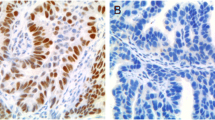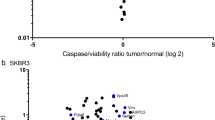Abstract
Antibodies specific for human p53 were analysed in sera of lung cancer patients. We detected p53 antibodies in the sera of 24% (10/42) of patients with lung carcinoma. The distribution was as follows: 4/9 small-cell lung carcinomas (SCLCs), 2/18 squamous cell lung carcinomas (SCCs), 2/10 adenocarcinomas (ADCs) and 2/5 large-cell lung carcinomas (LCCs). p53 antibodies were always present at the time of diagnosis and did not appear during progression of the disease. Using an original peptide-mapping procedure, we precisely localised the p53 epitopes recognised by p53 antibodies. Immunodominant epitopes reacting with antibodies were localised in the amino and carboxy termini of the protein, similar to those found in breast carcinoma patients or in animals immunised with p53. In light of these data, we suggest that p53 antibodies occur via a self-immunisation process that is the consequence of p53 accumulation in tumour cells. p53 antibodies were also detected in two patients without detected malignant disease. One of these patients died 6 months later of lung carcinoma, suggesting that p53 antibodies may be a precocious marker of p53 alteration.
Similar content being viewed by others
Author information
Authors and Affiliations
Rights and permissions
About this article
Cite this article
Schlichtholz, B., Trédaniel, J., Lubin, R. et al. Analyses of p53 antibodies in sera of patients with lung carcinoma define immunodominant regions in the p53 protein. Br J Cancer 69, 809–816 (1994). https://doi.org/10.1038/bjc.1994.159
Issue Date:
DOI: https://doi.org/10.1038/bjc.1994.159
- Springer Nature Limited
This article is cited by
-
Nontoxic virus nanofibers improve the detection sensitivity for the anti-p53 antibody, a biomarker in cancer patients
Nano Research (2015)
-
Detection of serum p53 antibodies from Chinese patients with papillary thyroid carcinoma using phage-SP-ELISA: correlation with clinical parameters
Endocrine (2014)
-
Early detection of cancer in the general population: a blinded case–control study of p53 autoantibodies in colorectal cancer
British Journal of Cancer (2013)
-
Prognostic significance of telomerase activity and some tumor markers in non-small cell lung cancer
Medical Oncology (2011)
-
A systematic review of humoral immune responses against tumor antigens
Cancer Immunology, Immunotherapy (2009)




